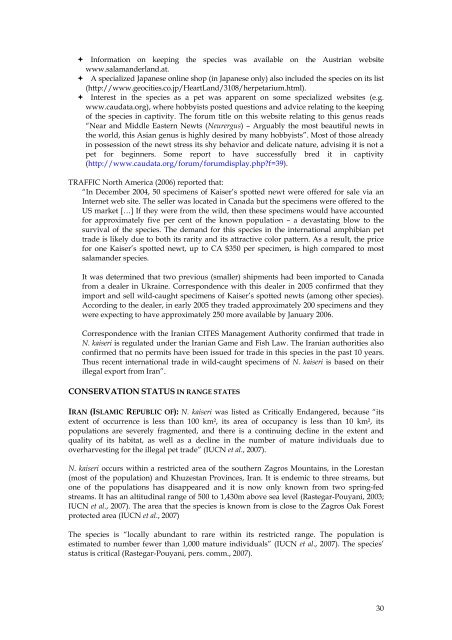review of non-cites amphibia species that are known or likely to be ...
review of non-cites amphibia species that are known or likely to be ...
review of non-cites amphibia species that are known or likely to be ...
You also want an ePaper? Increase the reach of your titles
YUMPU automatically turns print PDFs into web optimized ePapers that Google loves.
Inf<strong>or</strong>mation on keeping the <strong>species</strong> was available on the Austrian website<br />
www.salamanderland.at.<br />
A specialized Japanese online shop (in Japanese only) also included the <strong>species</strong> on its list<br />
(http://www.geocities.co.jp/HeartLand/3108/herpetarium.html).<br />
Interest in the <strong>species</strong> as a pet was app<strong>are</strong>nt on some specialized websites (e.g.<br />
www.caudata.<strong>or</strong>g), where hobbyists posted questions and advice relating <strong>to</strong> the keeping<br />
<strong>of</strong> the <strong>species</strong> in captivity. The f<strong>or</strong>um title on this website relating <strong>to</strong> this genus reads<br />
“Near and Middle Eastern Newts (Neurergus) – Arguably the most <strong>be</strong>autiful newts in<br />
the w<strong>or</strong>ld, this Asian genus is highly desired by many hobbyists”. Most <strong>of</strong> those already<br />
in possession <strong>of</strong> the newt stress its shy <strong>be</strong>havi<strong>or</strong> and delicate nature, advising it is not a<br />
pet f<strong>or</strong> <strong>be</strong>ginners. Some rep<strong>or</strong>t <strong>to</strong> have successfully bred it in captivity<br />
(http://www.caudata.<strong>or</strong>g/f<strong>or</strong>um/f<strong>or</strong>umdisplay.php?f=39).<br />
TRAFFIC N<strong>or</strong>th America (2006) rep<strong>or</strong>ted <strong>that</strong>:<br />
“In Decem<strong>be</strong>r 2004, 50 specimens <strong>of</strong> Kaiser’s spotted newt were <strong>of</strong>fered f<strong>or</strong> sale via an<br />
Internet web site. The seller was located in Canada but the specimens were <strong>of</strong>fered <strong>to</strong> the<br />
US market […] If they were from the wild, then these specimens would have accounted<br />
f<strong>or</strong> approximately five per cent <strong>of</strong> the <strong>known</strong> population – a devastating blow <strong>to</strong> the<br />
survival <strong>of</strong> the <strong>species</strong>. The demand f<strong>or</strong> this <strong>species</strong> in the international <strong>amphibia</strong>n pet<br />
trade is <strong>likely</strong> due <strong>to</strong> both its rarity and its attractive col<strong>or</strong> pattern. As a result, the price<br />
f<strong>or</strong> one Kaiser’s spotted newt, up <strong>to</strong> CA $350 per specimen, is high comp<strong>are</strong>d <strong>to</strong> most<br />
salamander <strong>species</strong>.<br />
It was determined <strong>that</strong> two previous (smaller) shipments had <strong>be</strong>en imp<strong>or</strong>ted <strong>to</strong> Canada<br />
from a dealer in Ukraine. C<strong>or</strong>respondence with this dealer in 2005 confirmed <strong>that</strong> they<br />
imp<strong>or</strong>t and sell wild-caught specimens <strong>of</strong> Kaiser’s spotted newts (among other <strong>species</strong>).<br />
Acc<strong>or</strong>ding <strong>to</strong> the dealer, in early 2005 they traded approximately 200 specimens and they<br />
were expecting <strong>to</strong> have approximately 250 m<strong>or</strong>e available by January 2006.<br />
C<strong>or</strong>respondence with the Iranian CITES Management Auth<strong>or</strong>ity confirmed <strong>that</strong> trade in<br />
N. kaiseri is regulated under the Iranian Game and Fish Law. The Iranian auth<strong>or</strong>ities also<br />
confirmed <strong>that</strong> no permits have <strong>be</strong>en issued f<strong>or</strong> trade in this <strong>species</strong> in the past 10 years.<br />
Thus recent international trade in wild-caught specimens <strong>of</strong> N. kaiseri is based on their<br />
illegal exp<strong>or</strong>t from Iran”.<br />
CONSERVATION STATUS IN RANGE STATES<br />
IRAN (ISLAMIC REPUBLIC OF): N. kaiseri was listed as Critically Endangered, <strong>be</strong>cause “its<br />
extent <strong>of</strong> occurrence is less than 100 km², its <strong>are</strong>a <strong>of</strong> occupancy is less than 10 km², its<br />
populations <strong>are</strong> severely fragmented, and there is a continuing decline in the extent and<br />
quality <strong>of</strong> its habitat, as well as a decline in the num<strong>be</strong>r <strong>of</strong> mature individuals due <strong>to</strong><br />
overharvesting f<strong>or</strong> the illegal pet trade” (IUCN et al., 2007).<br />
N. kaiseri occurs within a restricted <strong>are</strong>a <strong>of</strong> the southern Zagros Mountains, in the L<strong>or</strong>estan<br />
(most <strong>of</strong> the population) and Khuzestan Provinces, Iran. It is endemic <strong>to</strong> three streams, but<br />
one <strong>of</strong> the populations has disappe<strong>are</strong>d and it is now only <strong>known</strong> from two spring-fed<br />
streams. It has an altitudinal range <strong>of</strong> 500 <strong>to</strong> 1,430m above sea level (Rastegar-Pouyani, 2003;<br />
IUCN et al., 2007). The <strong>are</strong>a <strong>that</strong> the <strong>species</strong> is <strong>known</strong> from is close <strong>to</strong> the Zagros Oak F<strong>or</strong>est<br />
protected <strong>are</strong>a (IUCN et al., 2007)<br />
The <strong>species</strong> is “locally abundant <strong>to</strong> r<strong>are</strong> within its restricted range. The population is<br />
estimated <strong>to</strong> num<strong>be</strong>r fewer than 1,000 mature individuals” (IUCN et al., 2007). The <strong>species</strong>’<br />
status is critical (Rastegar-Pouyani, pers. comm., 2007).<br />
30

















